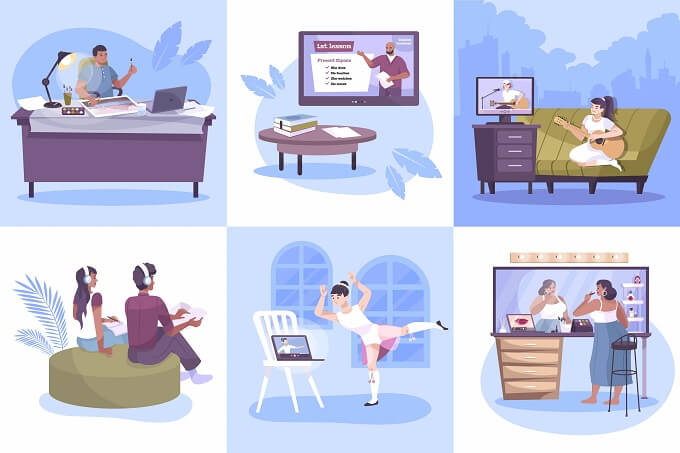With more popularity industry also becomes more challenging. If you want sales & clients, then you must offer high quality.
Today’s article will look at the top 20 best practices you can incorporate into virtual training programs to take them to the next level.
So, if you are ready, let’s start!
The following article covers:
Pre-training best practices
It is not just about what you can do during but also what you can do before to make the during & after better.
So, first of all, let’s take a look at a few tips you can use you prepare for the virtual training & deliver high quality later on.
#1 Elaborate on teaching goals
The first step toward success is to set measurable goals. Your goals should be more than measurable they should be SMART.
The SMART goal-setting technique stands for specific, measurable, achievable, realistic, and time-specific goals.
When you are clear on teaching goals, you better understand what value your training can provide students. Therefore, you can use it in marketing & while closing deals.
So, set clear objectives that you can use in the course outline, in marketing, and generally as a motivational factor that also clears things up.
#2 Be ready for challenges
The next step is always to be ready for challenges.
If you are a beginner in the training industry or just in virtual training, you will face particular challenges. But with practice, you will achieve mastery.
Most of the challenges may arise due to technicalities. For instance, you may lose connection to the internet, or equipment, including online software, may break down. However, most of these issues have a quick & easy fix. For instance, if you lose wi-fi, make sure always to have extra mobile data.

Try meditation if a challenge is related to anxiety before the session. Also, you can listen to coming music, avoid coffee, or drink some tea. Remember that your students might be as worried, and you, as an instructor, must set the right tone. Be yourself, and they will value it.
Simply be ready for challenges and calmly try to find solutions. There is absolutely no need to panic.
#3 Choose a platform you’d love
Let’s be honest; loving the platform you use is vital. There are lots of platforms available. People can recommend different things, yet if you are not comfortable with the platform, it will cause lots of difficulties.
Just make sure the platform of your choice is a full-featured LMS automation. It will ease up business processes saving time & allow for powerful customization.
A few platforms you can look into include Uteach, Thinkific, and Kajabi.
#4 Come up with assessment strategies
Before creating the training program or starting the session, come up with certain assessment strategies you will utilize.
Assessments will help you to keep students engaged and make sessions more interactive. High interaction & engagement levels throughout the training contribute to higher knowledge retention rates.
Plus, with the right assessments, you will be able to maintain attention better and keep the session focused.
Using correctly utilized assessment strategies will only benefit you and your students, improving the training program & contributing to better overall results.
#5 Troubleshoot technical problems
We have already mentioned that technical issues are one of the challenges you may face. So, make sure to troubleshoot everything before the start.
Check out whether the video conferencing works and whether the microphone & noise cancellation is on point. Of course, also check out the tools you are going to use and whether or not they work correctly, including whiteboards, & other collaborative learning tools.

Also, check if your presentation is finalized.
While-training best practices
Finally, it is time to look at the best practices to utilize during the training. Are you ready? Well, let’s start.
#6 Tell your students what to expect
If you want your training to be efficient, do not be afraid to set expectations upfront.
Setting expectations will help you to avoid dissatisfied customers, low engagement rates, failed training, and bad reviews. Aren’t these advantages just enough to set them?
At the start of the session, tell students what the session is going to be about, what you are focusing on, and what the learning outcomes are. Also, do not forget to share your expectations of their behavior, such as being engaged, answering questions, working in groups, etc.
#7 Warm up the virtual classroom
The next tip is to warm up the virtual classroom before the start of the learning part. When students have just joined the session, do some warm-up. For instance, you can play a warm-up game, and use virtual icebreakers that will contribute to the friendly atmosphere if it is the program’s first session.
If it is the second, third, or another session, you can do a warm-up quiz on what they remembered from the previous session.
#8 Make your students interact more
If you ensure your student’s interaction levels are high, you will see how their progress improves. At the end of the training, the results will be better.
So, incorporate various collaborative learning approaches, including peer & group work, for improving engagement & interaction levels. You can also utilize gamification technology to make sure the training is interactive.
Even visual materials such as presentations & infographics can contribute to interaction levels if they are dynamic.
#9 Avoid tedious lectures
You can go with tedious lectures if you want bored students and low knowledge retention rates. However, if you want engaged students, good training results, and good reviews, then avoid tedious lectures.
Training is not formal academic education. Therefore, expectations from it are also different. If you start lecturing students forgetting to involve them in the process, it simply will be inefficient.
#10 Include multimedia elements in the presentation.
Another tip that will help you greatly improve online training sessions’ overall quality and efficiency is incorporating multimedia elements into the presentation. Multimedia means using different visual content forms, including texts, images, graphics, animations, videos, and others.

If your presentation consists only of background & text, it will indeed be boring. For instance, when creating a presentation, follow simple rules, such as:
- Use a similar or the same color scheme as you use for branding to make presentations unique and outstanding, and consider exploring beautiful font pairings for your brand to enhance the overall design
- Stick to modern-style of presentations and remember it is better to have more slides than fewer slides but lots of information on one
- Use appropriate multimedia elements, and make sure the font matches the graphics
- Do not forget about the white spaces.
Post-training best practices
Let’s also review the best practices you can use post-training to ensure your training is efficient.
#11 Reflect on the session
After the training, do not forget to spend time reflecting on the session. Reflecting on the session, whether or not initial objectives were achieved, how effective discussions were, etc., will help you better understand the overall situation. Therefore, allow you to improve further the techniques or practices you incorporate to achieve the best possible outcomes.
Reflection on the session will be even more efficient if you ask for students’ feedback. Suppose you do not have much time for a long discussion. Then, create a short form with questions you want to find answers to related to the session. After each session, students can fill out the form and provide you with feedback for further growth.
#12 Find out if there’s a need for extra help
Follow up on students after the session and before the next one. Ask them if everything is clear and whether or not they need additional help with preparation for the next session.
This way, you will provide more value & care, which will improve the trust factor toward you as an instructor.
#13 Provide additional resources
To enhance the learning experience, you can also provide students with additional learning materials & resources. These will help them cover the topics more in-depth and maintain their interest throughout the program.
Additional resources can be third-party resources such as books, guiding pdfs, links to YouTube videos, or resources you have created. Search for or create podcasts, audio, and videos that will further cover the material providing additional details on it.
#14 Grow on the feedback you get
One thing is to ask for feedback and ignore it; another is to grow on it.
Do not ask for feedback just because everyone else does or just because you want students to feel heard. That is a complete waste of your and the participants’ time.

Ask for feedback, analyze the feedback, and come up with further strategies for improvement and growth.
#15 Continue learning
As a virtual trainer who comes up with updated programs, you must realize that the training industry also gets updates. Methodologies change, technology changes, and so on.
So, to be on top, you must always be open to new knowledge related to your expertise and the training industry as a whole. Participate in training yourself, learn from others and grow your network.
Learning & knowledge are the most powerful tools for growth.
Best practices to stand out from the crowd
It is no secret that industries on demand, such as online learning, have a good level of competition. Therefore, you need a strong USP (unique selling point) to help you stand out.
#16 Employ flipped classroom approaches
Flipped classroom approaches can unimaginably improve the quality of the training. So, what exactly flipped classroom is?
Well, it is based on the idea that lectures are not the best way for effective sessions. So, students acquire information (theory) before the session starts, which allows them to engage in higher-level activities throughout the class.
For instance, if you are hosting a sales training, you might as well provide a presentation on a particular session topic beforehand. Ask students to familiarize themselves with the material. This will allow for more productive training secession to take place later on.
#17 Create a community of practice
Build a community. You can build a community with your students where they will be able to help one another out. Also, they can share useful tips & tricks even their further progress after your training. This way, you and your students will be connected to one another.
A good community will contribute to an increased trust factor. It also can increase the number of returning customers as well as contribute to better word-of-mouth marketing.
#18 Conduct student progress reviews
Student Progress Reviews usually are conducted within universities and higher education institutions. Yet, if you decide to implement this tactic, it can help you to stand out from the rest of the trainers.
Essentially you ask students to give feedback on their own progress, such as reflection on their accomplishments, set goals & even challenges they have faced.
This way, you will encourage students to be more responsible toward themselves & their education while also improving their self-awareness.
#19 Employ choose-your-own-adventure style
Choose-your-own-adventure is a model of learning that widely gains popularity. It is a very good model for keeping students engaged & motivated as they are given a choice of what to study, how to accomplish tasks, etc.
It allows students to
- Vote on course material
- Decide how to complete tasks
- So on.
This type of learning is easier to implement than pre-recorded training that is sold as online courses. You can make the learning more personalized by showing students materials based on their selected goals & expectations from the course.

In real-time sessions, you can allow them to vote on course material & activities.
Using this adaptive learning strategy, you will improve interaction levels.
#20 Collect new training ideas to bring freshness
It is time to collect new ideas from your students. Most trainers forget how powerful the ideas of students can be. Your students are your target market, and the insights they will give you are pretty much the most useful than any AI writer will provide.
So, carefully listen to their feedback and ideas & it will help you not only in the creation of better programs but also in grabbing completely new approaches for making training more efficient.
Put these into practice with Uteach
If you want to grow your audience, have a full-featured online Training Business, scale & make profits, then put all of these tips into practice with Uteach.
Uteach is an incredible automation that allows you to create a white-labeled website with drag & drop editor, customize & publish training and courses, host live sessions & benefit forms seamless integrations with your favorite tools. It automates lots of processes that save a great deal of time, allowing you to focus on actions that will bring a higher return on investment.
It is an affordable yet potent solution to start & expand your online training business.


![How to Start Online Coaching Business [Proven Strategies]](https://d35v9chtr4gec.cloudfront.net/uteach/articles/LXoil0HbCqKEO2lAdpzG-1693384984/start-online-coaching-business.jpg)
